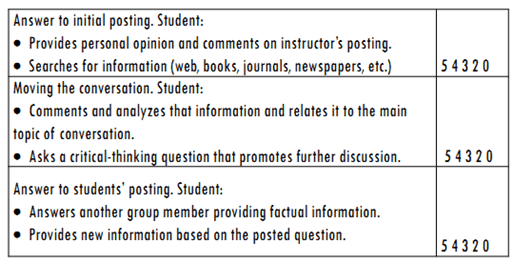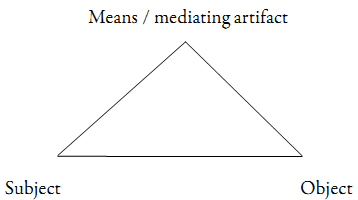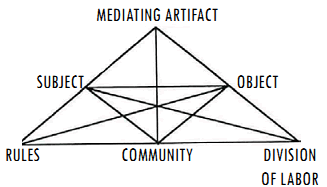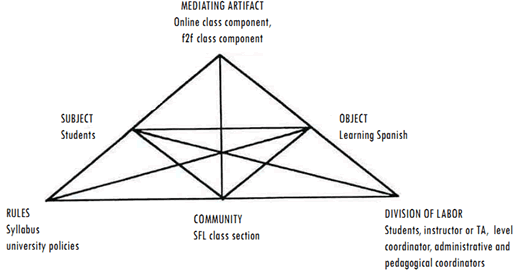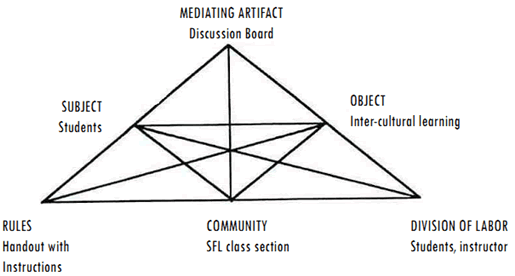Services on Demand
Journal
Article
Indicators
-
 Cited by SciELO
Cited by SciELO -
 Access statistics
Access statistics
Related links
-
 Cited by Google
Cited by Google -
 Similars in
SciELO
Similars in
SciELO -
 Similars in Google
Similars in Google
Share
Íkala, Revista de Lenguaje y Cultura
Print version ISSN 0123-3432
Íkala vol.17 no.3 Medellín Sept./Dec. 2012
ARTÍCULOS DE INVESTIGACIÓN
THE ROLE OF THE FIRST LANGUAGE IN HYBRID SPANISH AS A FOREIGN LANGUAGE CLASSES: A SIN OR A TOOL?
EL PAPEL DE LA PRIMERA LENGUA EN CLASES SEMIPRESENCIALES DE ESPAÑOL COMO LENGUA EXTRANJERA: ¿UN PECADO O UNA HERRAMIENTA?
Laura Colombo*
* holds a PhD in Language, Literacy and Culture from the University of Maryland, United States. She currently has a postdoctoral fellowship for the National Council of Technical and Scientific Research in Argentina. Mailing address: 25 de mayo 210 - 1er piso, Instituto de Lingüística, CP (1002), CABA, Argentina. E-mail: violetalaura@umbc.edu.
Received: 06-03-12 / Reviewed: 08-07-12 / Accepted: 08-23-12 / Published: 12-01-12
How to reference this article: Colombo, L. (2012). The role of the first language in hybrid Spanish as a foreign language classes: A sin or a tool? Íkala, revista de lenguaje y cultura, 17(3), 245-262.
ABSTRACT
The use of the first language (L1) in the foreign language classroom has been highly contested in the last decades. This paper discusses the use of L1 in online activities in hybrid lower-level Spanish as a foreign language (SFL) courses, with a focus on threaded discussions about cultural topics. I first discuss the use of L1 in foreign language (FL) teaching. Second, I present Vygotsky's (1978) postulates about learning, and Cole and Engeström's (2001) activity theory. Third, I conduct an activity analysis of the SFL class to further narrow it down to L1 use in the discussion boards. By looking at the discussion boards through the lens of sociocultural theories, I claim that the use of L1 is a necessary cognitive tool for fostering inter-cultural learning through online discussions in SFL classes.
Keywords: first language use, sociocultural theories, Spanish as a foreign language, online discussions, culture teaching
RESUMEN
El uso de la lengua materna o primera lengua (L1) en clases de lengua extranjera ha generado controversia en las últimas décadas. Este artículo discute el uso de L1 en cursos semipresenciales del nivel inicial de Español como Lengua Extranjera (ELE), centrándose en foros de discusión en línea sobre temas culturales. Luego de discutir el uso de L1 en la enseñanza de lenguas extranjeras, se presentan los postulados de Vygotsky (1978) sobre el aprendizaje y la teoría de la actividad propuesta por Cole y Engeström (2001). A continuación, se analiza la clase ELE como un sistema de actividad, acotando el mismo al uso de L1 en foros de discusión en línea. Se concluye que, desde el marco conceptual de las teorías socioculturales, es necesario el uso de L1 en los foros de discusión en línea ya que constituye una herramienta cognitiva necesaria para fomentar el aprendizaje intercultural.
Palabras clave: uso de la primera lengua, teorías socioculturales, Español como lengua extranjera, discusiones en línea, enseñanza de la cultura
1. L1 USE IN THE FACE-TO-FACE (F2F) FL CLASSROOM
L1 use in foreign language study has appeared in the scholarly narratives of SLA and FLT as the greatest crime of the learner, a sin to be avoided at all costs (Belz, 2003a, p. 211)
The use of L1 in the f2f1 FL classroom has been contested, advocated and even ignored by different teaching methodologies and theoretical frameworks. According to Ellis (2001) ''the dismissal of a significant role for the learner's L1 in L2 [second language] learning [...] occurred when behaviorist models of language learning were rejected'' (p. 126). When the Direct Method emerged as a reaction to the Grammar Translation method, it also brought with it the exclusive use of L2 in foreign language teaching (Auerbach, 1993, p. 15; Omaggio-Hadley, 2001, p. 57). This avoidance of L1 in the classroom and in teaching materials has persisted until the present day.
According to Cook (2001), current methods in language teaching such as the communicative language teaching and task-based learning methods do not directly ban L1 use, nonetheless the L1 is only mentioned ''when advice is given on how to minimize its use'' (p. 404). As a matter of fact, Ballman, Liskin-Gasparro, and Mandell (2001) illustrate this position when they assert that ''it is imperative that Spanish [L2] be the primary language used in the classroom'' (p. 63) and even devote a whole section of their book to explaining how to avoid L1 use.
In addition, Cook (2001) relates the banning and the omission of L1 in the classroom to, among other things, one of the basic assumptions that constituted the foundations of language teaching in the twentieth century: the ''monolingual principle'' (p. 404). However, this principle did not enjoy absolute homogeneity since at least three methods proposed a systematic use of L1 in the classroom: New Current Method, Community Language Learning, and Dodson's Bilingual Method. Cook further postulates that L1 is actually used in every FL classroom, even in those where its use is banned or not accepted. However, the idea that L2 teachers should avoid using L1 in their L2 classes still prevails (Moore, 2002). In short, except the few aforementioned methods, L1 avoidance has constituted the main paradigm in language teaching methodologies in the last decades.
L1's place in teaching methodologies is similar to its place in language teaching research. According to Chavez (2003), ''L1 use makes not only for poor pedagogical practice but for a questionable research focus'' (p. 166). As a result, studies centering on L1 are fairly new (Ellis, 2001) and most of them stress how to reduce its use in the classroom, giving L1 a marginal place in FL research.
Early studies focused on the L1 transfer role analyzed the positive or negative influence that the L1 had on the L2. Some studies showed a negative transfer from L1 to L2 (for example Schweers, 1995) while others demonstrated a positive transfer of writing and literacy skills (Berman, 1994; Crerand, 1993; Pennington & So, 1993; Sasaki & Hirose, 1996) in L1 to L2. Furthermore, it was found that the cross-linguistic transfer can be bi-directional, with students applying writing strategies acquired in L2 composition when writing in L1 (Akyel & Kamişli, 1996). Research centered on negative or positive transfer is based on what Cook (2001) calls ''language compartmentalization'' (p. 407) which entails the assumption that L1 and L2 are compartmentalized in two different systems that influence each other. Actually, most of the aforementioned studies measured separately L1 abilities and later contrasted them with L2 use, trying to define how these two separate processes would influence each other. This correlates with the monolingual principle that Cook (2001, p. 405) claims has dominated language teaching in the twentieth century and has led to L1 avoidance in the classroom.
Research also exists on L1 use in f2f oral interactions in the classroom, focusing on the amount of L1 used by teachers and students as well as the functions and contexts of usage. Findings indicate that teachers and students tend to use more L2 in the classroom. However, researchers insist that L2 should be used even in those situations where the L1 was preferred (Burnett, 1998; Duff & Polio, 1990) or propose to identify the functions with which L1 use is strongly associated to systematize its use (Levine, 2003; Macaro, 2001).
Further studies that analyzed L1 use in f2f classroom interactions made use of the sociolinguistic notion of code-switching. These studies conceive L1 use as related to discourse functions and students' identities (Legenhausen, 1991; Liebscher & Dailey-O'Cain, 2005) as well as to types of audience (Hancock, 1997). Therefore, contrary to what is commonly believed (see for example Poulisee & Bongaerts, 1994) L1 is not seen only as a compensatory strategy when students lack L2 knowledge. Instead, these studies see code-switching in the classroom as fulfilling communication purposes and starting out negotiations of content and form that enrich the learning process (Moore, 2002).
To a larger or lesser degree, studies that draw on the notion of code-switching profess that L1 should be used in the classroom only if it does not hinder L2 development. If L1 use is accepted in the classroom, it should be defined when and how to better use it. According to Chavez (2003) this position is based on the mistaken assumption that there is a lineal and direct relationship between L1 use and L2 development, with a decrease in L1 use leading in a straightforward manner to an increase in L2 proficiency and vice versa. In addition to studies centered on language positive or negative transfer and to those studies based on the oral use of L1 in the classroom, there exists a bulk of research around L1 use in composing processes.
Process theories about writing and cognitivist approaches to the composing process that emerged at the end of the 90s opened the door for research centered on L1 use while composing in L2. Contrary to research based on transfer across languages and L1 use in the classroom, research centered on the composing process in L2 considers that ''the L2 writing process is a bilingual event'' (Wang & Wen, 2002, p. 239) and that L1 is a natural intervening factor. Most of these studies used think-aloud protocols to examine the role that L1 played in the cognitive processes that lie beneath the L2 composing process. Findings indicate that the amount of L1 use is associated with the type and level of demand of the task (Qi, 1998; Wang & Wen, 2002; Woodall, 2002), students' proficiency level (Qi, 1998; Wang & Wen, 2002; Whalen & Ménard, 1995; Woodall, 2002), as well as with the functions attributed to L1 in the composing process (Qi, 1998; Wang & Wen, 2002). In addition, the majority of these studies did not conceptualize L1 as something that has to be avoided but as a resource for the L2 composing process and for research methodologies2 . L1 use, thus, was seen as something natural and beneficial. Nevertheless, as Belz (2003a) states, ''the limit of its usefulness lies in the ways in which it can serve the acquisition of the L2'' (p. 215). Among these studies lies a conceptualization of L1 use as a ''crutch'' in the composing process, especially when cognitive demands are high (for example, Woodall, 2002, p. 8). Therefore, there is a possibility that not even one of these studies envisions the use of L1 as a ''conscious discourse strategy'' (Belz, 2003a, p. 214) and they picture learners as having a ''deficit''. Accordingly, L1 use appears as a factor that would desirably disappear with the development of L2 proficiency.
Another theory that framed research on L1 use is sociocultural theory. Most of the studies based on sociocultural theory revolve around the analysis of collaborative interactions and focus on the oral discourse produced by students when solving a specific task. Similar to research based on writing processes, these studies also conceptualized L1 use as a mediating cognitive tool. Nevertheless, as Antón and DiCamilla (1998) notice, none of the early studies ''focuse[d] on the role of L1 in their subjects' interactions'' (p. 320). As an illustration, it is only in the discussion section that De Guerrero and Villamil (1994) mention the uses of L1 in their analysis of the social-cognitive dimensions during L2 peer review in an EFL classroom. The authors acknowledge that L1 has a ''powerful role as an instrument of task control'' (De Guerrero & Villamil, 1994, p. 492) and that most of the students interacted using L1. Notwithstanding, they do not signal the use of L1 in the transcripts of the conversations they offer as examples in their paper. Along the same line, Brooks and Donato (1994) also comment on L1 use in their analysis of collaborative tasks among English-speaking students in a Spanish as a Foreign Language (SFL) classroom. They state that L1 use ''facilitates L2 production and allows the learners both to initiate and sustain verbal interaction with one another'' (p. 268). Swain and Lapkin (1998), like De Guerrero and Villamil, only mention in their discussion section the use of L1, stating that it is used by the learners as a mediational tool for producing in L2.
The role of L1 as a meditational tool is also recognized by Swain (2000), who acknowledges that ''the use of the first language to mediate second language learning creates a situation where the use of language as a mediating tool is particularly clear'' (p. 114). In 2000, Swain and Lapkin analyzed the uses of the L1 in task- based learning but they conducted their study on bilingual immersion programs and not on the FL classroom. The only authors that to my knowledge have centered their analysis specifically on L1 use in the FL classroom are Antón and DiCamilla (1998). These authors studied how adult English-speaking students in a beginning SFL course used their L1 (English) when working in dyads to produce texts in L2 (Spanish). They identified several cognitive and social functions for L1 use. They asserted that ''use of L1 is beneficial for language learning, since it acts as a critical psychological tool that enables learners to construct language tasks'' (p. 337). As it can be observed, studies informed by sociocultural theories have re-framed the role of L1 in the FL classroom. These studies showed that L1 use is not something that must be avoided at all costs in the FL classroom but that it serves as a mediating tool in L2 acquisition.
In summary, L1 use has had a marginal place among teaching methodologies and research on FL teaching. As reported by Cook (2001), only three teaching methodologies in the past (New Current Method, Community Language Learning, and Dodson's Bilingual Method) have advocated for a systematic use of the L1 in the FL classroom. In addition, as showed in the literature review, when L1 use has been researched, it has been conceptualized as: (1) a separate system that transfers negatively or positively to L2; (2) as something that must be avoided or, in the best of the cases, minimized; and (3) as an intervening factor in composing processes that would desirably disappear with the increase of L2 proficiency. It is just recently that L1 use has been brought into attention by sociocultural theories of learning as a cognitive tool that can lead to L2 acquisition. As Chavez (2003) claims, ''while the issue of L1 use is probably still far from being palatable to all, at least it is beginning to reach a broader audience'' (p. 166). However, as previously stated, there is limited research on the use of L1 in the f2f classroom as a tool that can enhance L2 learning.
2. L1 USE IN THE ONLINE FL CLASSROOM: ARE WE STILL SINNERS?
The lack of research on and the marginal place of L1 use in FL research are even more pronounced when we turn to the field of computer mediated communication (CMC) in FL language teaching.
There seems to be a lack of studies that analyze L1 use in the FL online classroom. This may be due to the fact that most research has praised the advantages of using CMC in the FL classroom as a tool that allows access to authentic materials and native speakers. Therefore, most works are based on the possibilities that multimedia and web technologies open to get students in contact with native speakers of the target language, especially when used to promote inter-cultural learning.
There are some studies that are not focused on but only report on the use of L1 in CMC in the FL classroom. For example, Oskoz and Elola (2008) state that in O'Dowd's (2003) and Belz's (2003b) studies, students used their L1 but only when correcting their partners' errors. Along the same lines, Bauer, deBenedette, Furstenberg, Levet, and Waryn (2006) mention that in the Cultura project3 ''all students write in their L1 on the forums'' (p. 31). However, the authors also assert that this ''is an important and frequently misunderstood aspect of Cultura'' (p. 31) and they proceed to offer a rather lengthy explanation that justifies L1 use in the discussion boards. Oskoz's and Elola's (2008) study also reports the use of L1 in CMC in the FL classroom. Similar to Bauer and colleagues, the authors devote a section of the paper to justify L1 use in CMC by claiming that it constitutes a mediating tool between the L1 and the L2 culture. The use of L1, the authors assert, allows learners to reflect on their understanding of their own and others' culture, which leads to a process of interpretation and discovery. As it can be observed, studies on CMC in the FL classroom show a similar trend to those centered on f2f FL instruction: L1 use continues to be a sin. And again, those that openly advocate for L1 use in CMC in FL education frame their ''justification'' in sociocultural theory.
In the following section, I present Vygotsky's (1978) ideas about learning and Cole and Engeström's (2001) activity theory in order to later apply it to the analysis of L1 use in discussion forums of SFL classes.
3. CAN SOCIOCULTURAL THEORIES OF LEARNING ABSOLVE US?
Sociocultural theory is based on Vygotsky's work. Central to his theory is the concept of mediation (also see Wertsch, 1997). Vygotsky (1978) argues that not only physical but also semiotic tools mediate human action: ''the most significant moment in the course of intellectual development, which gives birth to the purely human forms of practical and abstract intelligence, occurs when speech and practical activity, two previously completely independent lines of development, converge'' (p. 24). Language is seen as ''a particularly powerful semiotic tool'' that ''mediates our physical and mental activities'' (Swain, 2000, p. 104). That is, as humans, we do not act directly on the world but our actions are always mediated.
Therefore, in sociocultural theory, the unit of analysis is not the individual or a ''specific mental processes in vacuo'' (Wertsch, 1997, p. 5) but tool- mediated action. According to Vygotsky (1978), the dialectical unit of ''practical intelligence and sign use'' constitutes ''the very essence of complex human behavior'' (p. 24). This is what Cole and Engeström (2001) call ''the classical mediational triangle'' (p. 6), which ''fail[s] to account for the collective nature of human activities, or activities systems'' (p. 7). The authors, thus, propose activity systems as the basic unit of analysis to understand the development of human cognition and define this term by expanding the mediational triangle depicted in Figure 1.
Figure 1: The classical mediational triangle
According to Cole and Engeström (2001), activity systems are inherently social and they are in constant change. In their representation of the activity system, the authors see as mediated more than just the relation between subject and object. They propose a cultural-historical framework to analyze cognition as a distributed phenomenon and thus add three components to the activity system: rules, community, and division of labor (see Figure 2).
Figure 2: The basic mediational triangle expanded (Cole & Engeström, 2001, p. 8)
These authors describe their representation of the activity system as follows:
First, the fact that individuals (''subject'') are constituted in communities is indicated by the point labeled ''community'' [...] the relations between subject and community are mediated, on the one hand, by the group's full collection of ''mediating artifacts'' and, on the other hand, by ''rules'' (the norms and sanctions that specify and regulate the expected correct procedures and acceptable interactions among the participants). Communities, in turn, imply a ''division of labor,'' the continuously negotiated distribution of tasks, powers and responsibilities among the participants of the activity system. (Cole & Engeström, 2001, p. 7)
Conceptualizing human action in this framework allows us to broaden our analysis of L1 use in FL education. In this sense, we are not only centering our analysis on the mediated action of learners using L1 as a cognitive tool to achieve specific functions that allow L2 acquisition within a given task, but we are also situating the systematic use of L1 within the FL classroom as a means to inter- cultural learning.
In the following section, applying Cole and Engeström's theory, I first describe lower-level Spanish classes at a mid-size public university on the East Coast of the United States as activity systems. Then, I conduct an activity analysis of L1 use in the discussion boards as part of these SFL classes.
4. L1 AS A TOOL VERSION
Description of the SFL courses as activity systems
The lower-level SFL courses (first, second, and third semester courses) at this mid-size public university located on the East Coast of the United States are part of the undergraduate General Foundation Requirements (GFR) and Spanish is the most commonly taught second language at the university. This leads to a highly centralized and structuralized division of labor with its consequent rules. With one or two exceptions, the lower- level SFL courses are taught by graduate teaching assistants (TAs) and part-time instructors. These are standardized classes and TAs and instructors follow a centralized curriculum. Most of the rules for each class/activity system are in the syllabus and framed at a broader level by the general institutional policies of the university. Instructors and TAs meet weekly with a level coordinator to develop teaching and assessment materials. The level coordinator acts as a liaison with the pedagogical coordinator and the administrative coordinator. The pedagogical coordinator supervises and evaluates the materials produced during the meetings. The previous illustrates ''the distribution of tasks, powers and responsibilities among the participants'' (Cole & Engeström, 2001, p. 7) that constitute the division of labor in this activity system.
An example of one of the rules that ''specify and regulate the expected correct procedures'' (Cole & Engeström, 2001, p. 7) revolves around L2 use. Almost exclusive use of L2 is encouraged in the orientation sessions that TAs and part-time professors receive before the beginning of the semester. In addition, L2 use is also encouraged in the language methodology course that TAs take during their first semester teaching. Finally, the syllabus states that the course will be conducted in Spanish.
The course delivery format used in these classes is an important mediating artifact that regulates the subject(s) activities. The lower-level SFL courses are offered using the hybrid delivery format which combines traditional and online teaching approaches, meaning f2f instruction is complemented with an online component of the classes. The course management software used to support the internet-based component is Blackboard Academic SuiteTM (2007). During the course of the semester, classes meet two or three times a week for two and a half hours. Online activities are done outside of class hours. In Blackboard, in addition to the online activities, students can find the syllabus, materials posted by their TAs or instructors (not all of them use this feature), their grades, and links to websites with Spanish learning resources such as self-check exercises and online dictionaries. Online activities count as 15% of students' final grade, with 7.5% associated with four online chat activities and 7.5% to participation in four discussion boards. At the beginning of the semester (usually during the second week of classes) the class is held in a computer-equipped room and students are trained by instructors and TAs on how to use Blackboard. Additionally, students are also given handouts on how to complete the online activities. Students are required to use Spanish when completing the chats, though they participate in the discussion boards using their L14 .
The following figure represents a lower-level SFL class at the mentioned university as an activity system.
Figure 3: The SFL classroom as an activity system
As it can be observed in Figure 3, the online component of the class at this level acts as a mediating artifact between the subjects and the object. At the same time, it interacts with the other components of the activity system. It is embedded in the community defined as the specific section of SFL, in which participants share an objective, rules, and where there exists a division of labor. Although neither the level coordinators nor the pedagogical and administrative coordinators are physically present in each class section, the products of their work influence the way this community functions. For this reason, I added the coordinators in Figure 3.
In the following section, I explain and analyze the use of the discussion boards within the lower-level SFL classes and justify L1 use in them.
Discussion boards and inter-cultural learning
As described in the previous section, the students' objective (learning Spanish) is mediated by the f2f and online components of the class. The online component is divided into two kinds of activities: the chats and the participation in the discussion boards. In these SFL classes, the discussion boards are the mediating artifact through which students are expected to reflect on their understanding of their own and the others' culture. Therefore, the object of the discussion boards is inter-cultural learning. The following figure represents the activity system in which students are involved when participating in the discussion boards, which at the same time is nested in the class activity system.
As depicted in Figure 4, the rules for participating in the discussion board are stated in the handouts that the students are given at the beginning of the semester in the training session (Appendix A contains the handout). In addition to ''specif[ing] and regulat[ing]'' (Cole & Engeström, 2001, p. 7) students' participation in the discussion boards, the handout also states the object of this activity in which each section of the SFL classes (the community) will be involved. In this community, there is a division of labor in which students and teacher have ''specific tasks, powers and responsibilities'' (Cole & Engeström, 2001, p. 7). In addition, in this activity system the discussion board as a mediating artifact can be decomposed into different ''layers''. The first and broader layer is constituted by the discussion board as a task to be fulfilled as part of the SFL course where students are expected to engage in a dialogue with their peers in order to discuss and reflect on cultural issues (for a more detailed description see the section ''Pedagogical rationale'' in Appendix A). The second layer is constituted by the discussion board as an online technological tool that as such influences the ongoing dialogue among the participants. As it will be shown in the following section, both of these elements endorse the use of L1 in the discussion boards.
Figure 4: The discussion boards activity system in the SFL class
L1 as an inter-cultural learning tool in the discussion boards: Not a sin anymore.
The inclusion of inter-cultural learning as one of the objectives of FL instruction has developed rapidly in the last years (Belz & Thorne, 2006; Knutson, 2006; O'Dowd, 2003). Inter-cultural learning is related to the development of cross- cultural awareness and is based on the assumption that ''students cannot learn about values of another culture (C2) without considering those of their own'' (Knutson, 2006, p. 592). This entails ''broadening their horizon [...] by the discussion of cultural differences which may challenge their beliefs and values beyond the level of comfort'' (Dubriel, 2006, p. 238). Accordingly, the object of the discussion boards in these SFL classes is to offer students a space where they reflect not only on similarities and differences among cultures but also on others' and their own social identities. In order to achieve this, students should be able to ''express their views fully and in detail, formulate questions and hypothesis clearly, and provide complex, nuanced information'' (Bauer et. al, 2006, p. 35). This is not an easy task to be accomplished by students who are in beginning or intermediate FL classes. It is at this point where the use of L1 as a mediational means becomes imperative to achieve the object of the task. In this regard, Knutson (2006) proposes that ''it is certainly feasible to judiciously integrate the L1'' in the FL classroom if ''the activities or situations in which the L1 can be used are completely routinized [sic] and predictable'' (p. 605). The online environment in which the discussions are held, then, provides a physical and symbolic ''space'' where the use of L1 is accepted in the aforementioned SFL classes. In this sense, L1 usage is institutionalized and conceived as a mediational tool that allows students to achieve the object of the discussion boards: inter-cultural learning.
In addition to the nature of the task, the medium in which the discussions are held also supports the use of the L1. Belz and Thorne (2006) recognize that Internet-mediated intercultural foreign language education presents challenges ''especially in text- based media bereft of paralinguistic meaning signals'' (Belz & Thorne, 2006, p. xvi). The fact that in the online discussion the main (if not the sole) means through which the dialogue is carried out is written language adds a level of complexity. Thus, to carry out a discussion in a second language and in a written medium is not an easy task even in L1. As Sengupta (2001) asserts, ''in terms of the very nature of networked communication [...] discourse patterns may need adjusting to take into account the fact that there was no non-verbal contextual support'' (p. 123). Therefore, when the language output needs to be written, students may lack the sufficient linguistic flexibility needed to communicate complex thoughts in writing.
This linguistic flexibility is not only related to language proficiency but also to the cultures-of- use that are embedded in online communication. As Thorne (2003) defines it, cultures-of-use are the ''historically sedimented characteristics that accrue to a CMC tool from its everyday use [...] artifacts embody historical processes that shape, and are shaped by, human activity'' (p. 40). In this sense, the discussion board as a mediating artifact is not neutral. First, as a mediational means, it carries a functionality that is tied to its materiality and influences our actions: when participating in a discussion board, typically we type on a keyboard, read on the screen, etc. Second, the discussion board as a mediational means also ''takes its functionality from its histories of use'' (Thorne, 2003, p. 40). Scripted in the history of use of the SFL classes' discussion boards is the fact that the students are participating in an institutionally framed online space. This institutional frame is materialized in the interface of the management system used at the university (Blackboard), which at the time influences the way students act when using this mediational tool. If students were to participate in the discussion boards using their L2, they would be facing two contradictory objects: using the L2 and fully expressing their views. Most predictably, students would solve this contradiction by focusing their efforts in appropriately using the L2, which would contradict the object of the discussion boards: inter-cultural learning.
Therefore, the L1 use becomes necessary not only because of the object of the discussion boards in the activity system of the SFL classes but also due to the nature of the medium through which this object is achieved. In addition, conceptualizing L1 use as a cognitive tool that allows students to achieve the inter-cultural learning object also allows us to broaden the horizons of FL courses. As Knutson (2006) states, ''the understanding of self as culturally determined is closely associated with the humanistic values L2 education is designed to promote, and it is a valuable asset for lifelong learning as well'' (p. 599). It is in this sense that the object of language courses at the university level is undeniably linked to promoting in our students a broader understanding of their cultural selves and others.
If we are asking our students to take a step back and evaluate their own cultural assumptions in order to be able to critically evaluate others' culture, as educators, we should follow a similar path. Therefore, as educators and researchers, we should recognize that ''theoretical mindsets and narratives [...] are historically situated constructs that are influenced by a host of socio-cultural factors'' (Belz, 2003a, p. 211). As shown in the first sections of this paper, it is in these historically constituted narratives that the use of L1 in the FL classroom has been considered a sin in teaching and research settings. It was the purpose of this paper to show that sociocultural theories offer us an opportunity to go beyond these narratives and evaluate the constructs that mediate our pedagogical and research practices. The activity analysis of our classes allowed us to acknowledge inter-cultural learning as the object of the discussion board activity systems and therefore we stopped seeing L1 use as a sin. Once we recognized that in asking students to use L2 we were asking them to achieve two contradictory objects in the discussion board system, we decided to institutionalize the use of L1 in our classes. Given the nature of the task, the medium in which it was performed and the pedagogical objectives that we embraced, we framed L1 in such a way it became a cognitive tool to facilitate inter-cultural learning. In order to do this, we needed to take a step back and evaluate the constructs that mediated our pedagogical and research practices, challenging and changing them through theory.
AUTHOR'S NOTES
1 I define face to face classroom (f2f ) as in-class sessions where teacher and students are physically present in the same place.
2 When working with think-aloud protocols, most of the subjects externalize their composing process using their L1.
3 The Cultura project is an intercultural project that makes use of internet communication tools to develop students' understanding of the values and attitudes embedded in a foreign culture.
4 The term L1 is used here as opposed to L2. In the classes described in this section L1 means English since they are taught at an American university. However, no assumption is made that all students are native-English speakers.
REFERENCES
1. Akyel, A., & Kamişli, S. (1996). Composing in first and second languages: Possible effects of EFL writing instruction. Paper presented at the Balkan Conference on English Language Teaching of the International Association of Teachers of English as a Foreign Language, September 5-7, Istambul, Turkey. [ Links ]
2. Antón, M., & DiCamilla, F. (1998). Socio-cognitive functions of L1 collaborative interaction in the L2 classroom. The Canadian Modern Language Review, 54(3), 314-342. [ Links ]
3. Auerbach, E. (1993). Reexamining English only in the ESL classroom. TESOL Quarterly, 27(1), 9-32. [ Links ]
4. Ballman, T., Liskin-Gasparro, J., & Mandell, P. (2001). The communicative classroom: AATSP Professional Development (Vol. 2). Boston, MA: Heinle & Heinle. [ Links ]
5. Bauer, B., deBenedette, L., Furstenberg, G., Levet, S., & Waryn, S. (2006). The Cultura project. In J., Belz, & S., Thorne (Eds.), Internet-mediated intercultural foreign language education (pp. 31- 62). Boston, MA: Thomson Heinle. [ Links ]
6.Belz, J. (2003a). Identity, deficiency, and L1 use in foreign language study. In C., Blyth (Ed.), The sociolinguistics of foreign language classrooms: Contributions of the native, near-native and the non-native speaker (pp. 209-250). Boston, MA: Heinle & Heinle. [ Links ]
7. Belz, J. (2003b). Linguistic perspectives on the development of intercultural competence in telecollaboration. Language Learning and Technology, 7(2), 68-117. Retrieved from http://llt.msu.edu/vol7num2/belz/default.html [ Links ]
8. Belz, J., & Thorne, S. (2006). Internet-mediated intercultural foreign language education and the intercultural speaker (Introduction). In J. Belz, & S. Thorne (Eds.), Internet-mediated intercultural foreign language education (pp. x-xxv). Boston, MA: Thomson Heinle. [ Links ]
9. Berman, R. (1994). EFL essay writing: L1 versus L2 instruction. Paper presented at the Annual Meeting of TESOL, March 8-12, Baltimore, MD. [ Links ]
10. Blackboard Academic Suite Brochure (2007). Retrieved from http://www.blackboard.com/clientcollateral/Academic_Suite_Brochure_ New.pdf [ Links ]
11. Brooks, F., & Donato, R. (1994). Vygotskyan approaches to understanding foreign language learner discourse during communicative tasks. Hispania, 77, 262-274. [ Links ]
12. Burnett, J. (1998). Language alternation in a computer- equipped foreign language classroom: The intersection of teacher beliefs, language, and technology. The Canadian Modern Language Review, 55(1), 97-123. [ Links ]
13. Chavez, M. (2003). The diglossic foreign-language classroom: Learners' views on L1 and L2 functions. In C., Blyth (Ed.), The sociolinguistics of foreign language classrooms: Contributions of the native, near-native and the non-native speaker (pp. 163-208). Boston, MA: Heinle & Heinle. [ Links ]
14. Cole, M., & Engeström, C. (2001). A cultural-historical approach to distributed cognition. In G., Salomon (Ed.), Distributed cognitions: Psychological and educational considerations (pp. 1-46). New York, NY: Cambridge University Press. [ Links ]
15. Cook, V. (2001). Using the first language in the classroom. The Canadian Modern Language Review, 57(3), 402-423. [ Links ]
16. Crerand, M. (1993). From first language literacy to second language proficiency to second language literacy: the act of writing in a foreign language context. Paper presented at the Annual Meeting of the American Educational Research Association, April 12-16, Atlanta, GA. [ Links ]
17. De Guerrero, M., & Villamil, O. (1994). Social-cognitive dimensions of interaction in L2 peer revision. The Modern Language Journal, 78(4), 484-496. [ Links ]
18. Dubriel, S. (2006). Gaining perspective on culture through CALL. In L., Ducate, & N., Arnold (Eds.), Calling on CALL: from theory and research to new directions in foreign language teaching (pp. 237-268). San Marcos, TX: CALICO. [ Links ]
19. Duff, P., & Polio, C. (1990). How much foreign language is there in the foreign language classroom. The Modern Language Journal, 74, 154-166. [ Links ]
20. Ellis, R. (2001). SLA research and language teaching. New York, NY: Oxford University Press. [ Links ]
21. Hancock, M. (1997). Behind classroom code switching: layering and language choice in L2 learner interaction. TESOL Quarterly, 31(2), 217-235. [ Links ]
22. Knutson, E. (2006). Cross-cultural awareness for second/ foreign language learners. The Canadian Modern Language Review, 62(4), 591-610. [ Links ]
23. Legenhausen, L. (1991). Code-switching in learner's discourse. IRAL, 29(1), 61-73. [ Links ]
24. Levine, G. (2003). Student and instructor beliefs and attitudes about target language use, first language use, and anxiety: report of a questionnaire study. The Modern Language Journal, 87(3), 343-364. [ Links ]
25. Liebscher, G., & Dailey-O'Cain, J. (2005). Learner code-switching in the content-based foreign language classroom. The Modern Language Journal, 89(2), 234-247. [ Links ]
26. Macaro, E. (2001). Analysing student teachers' codeswitching in foreign language classrooms: theories and decision making. The Modern Language Journal, 85(4), 531-548. [ Links ]
27. Moore, D. (2002). Code-switching and learning in the classroom. International Journal of Bilingual Education and Bilingualism, 5(5), 279-293. [ Links ]
28. O'Dowd, R. (2003). Understanding the ''Other Side'': intercultural learning in a Spanish e-mail exchange. Language Learning and Technology, 7(2), 118-144. Retrieved from http://llt.msu.edu/vol7num2/odowd [ Links ]
29. Omaggio-Hadley, A. (2001). Teaching language in context. Boston, MA: Heinle & Heinle. [ Links ]
30. Oskoz, A., & Elola, I. (2008). Blogging: fostering intercultural competence development in foreign language and study abroad contexts. Foreign Language Annals, 41(3), 454-477. [ Links ]
31. Pennington, M., & So, S. (1993). Comparing writing process and product across two languages: a study of 6 Singaporean university student writers. Journal of Second Language Writing, 2(1), 41-63. [ Links ]
32. Poulisse, N., & Bongaerts, T. (1994). First language use in second language production. Applied Linguistics, 15(1), 36-57. [ Links ]
33. Qi, D. (1998). An inquiry into language-switching in second language composing processes. The Canadian Modern Language Review, 54(3), 413-435. [ Links ]
34. Sasaki, M., & Hirose, K. (1996). Explanatory variables for EFL students' expository writing. Language Learning, 46(1), 137-174. [ Links ]
35. Schweers, C. (1995). He uses a square shirt: First language transfer in the writing of Hispanic ESL learners. Viewpoints. (ERIC Document Reproduction Service No. ED 386924) [ Links ]
36. Sengupta, S. (2001). Exchanging ideas with peers in network-based classrooms: an aid or a pain? Language Learning and Techonology, 5(1). 103-134. [ Links ]
37. Swain, M. (2000). The output hypothesis and beyond: Mediating acquisition through collaborative dialogue. In J. Lantolf (Ed.), Sociocultural theory & second language learning. New York, NY: Oxford University Press. [ Links ]
38. Swain, M., & Lapkin, S. (1998). Interaction and second language learning: two adolescent French immersion students working together. The Modern Language Journal, 82(3), 320-337. [ Links ]
39. Swain, M., & Lapkin, S. (2000). Task-based second language learning: the uses of the first language. Language Teaching Research, 4(3), 251-274. [ Links ]
40. Thorne, S. (2003). Artifacts and cultures-of-use in intercultural communication. Language Learning and Technology, 7(2). 38-67. Retrieved from http://llt.msu.edu/vol7num2/thorne/ [ Links ]
41. Vygotsky, L. (1978). Mind in society. Cambridge, MA: Harvard University Press. [ Links ]
42. Wang, W., & Wen, Q. (2002). L1 use in the L2 composing process: an exploratory study of 16 Chinese EFL writers. Journal of Second Language Writing, 11, 225-246. [ Links ]
43. Wertsch, J. (1997). Voices of the mind: a sociocultural approach to mediated action. Cambridge, MA: Harvard University Press. [ Links ]
44. Whalen, K., & Ménard, N. (1995). L1 and L2 writers' strategic and linguistic knowledge: a model of multiple-level discourse processing. Language Learning, 45(3), 381-418. [ Links ]
45. Woodall, B. (2002). Language-switching: using the first language while writing in a second language. Journal of Second Language Writing, 11, 7-28. [ Links ]
APPENDIX A: INSTRUCTIONS FOR PARTICIPATING IN THE ONLINE DISCUSSION BOARDS
Pedagogical rationale
The purpose of the discussion boards is for you and your classmates to have the opportunity to talk about cultural customs in the US and the Spanish speaking countries. We encourage you to not only discuss about cultural differences that can be found in Spanish-speaking countries and the US but also to open a space for debate about the American culture itself. We do believe that language and culture are interrelated to each other and, therefore, learning a language other than yours also demands understanding the culture where the language is used. Thinking about differences and similarities between your culture and the target culture will help you to better express yourself in a second language. In order to allow you to fully express your thoughts and feelings, you will participate in the Discussion Boards in English. However, we encourage you to use some words in Spanish. For example, if you are talking about bullfighting, it would be good if you use the words ''corrida de toros'' or ''torero'' since they are related to events that belong to a specific culture.
For the Discussion Board activity, you will read descriptions of attitudes, ideas and practices which may vary in different cultures or countries. After reflecting on these, you will post your own ideas, insights and reactions to the cultural variations presented, and also comment on the ideas of other students. You have to complete five discussion boards.
The process is the following:
- You will read and answer the prompt provided by your instructor. When answering that question, you will provide additional information. The information will come from websites, journals, books, newspapers and other resources. You do not have to copy and paste information, but reflect on it and provide thought out comment to the retrieved information. You will also ask the group critical thinking questions.
- You will answer at least to one classmate. In your posting you will express agreement or disagreement, explain why (with specific information), and answer questions.
What is expected from the threaded discussions
- Evidence of reading postings, understanding and thinking about others' responses.
- Introduction of factual, conceptual knowledge to the discussion (personal experiences are welcome but are not the exclusive focus of the conversation).
- Postings that describe, analyze, compare findings.
- Clarity and comprehensiveness of threaded discussion.
- Identifiable sources.
- Good critical thinking questions.
What is not accepted from the threaded discussions
- Duplication of information.
- Providing exclusively personal information.
- Postings such as ''I agree with you''.
- Questions such as ''what do you think?'', ''have you been in that situation?''
Netiquette
When you address your classmates, be respectful. Do not post messages that are deliberately hostile or insulting. Avoid using inappropriate words and pay attention to your spelling. Remember that in a discussion board, you are what you write! Personalize your posts: when replying someone, add the name of the person you are replying to and sign your posts.
How to participate in the discussion boards
1. Go to Blackboard and log in. You can access blackboard from My UMBC or you can type in your browser blackboard.umbc.edu and the following screen will appear:
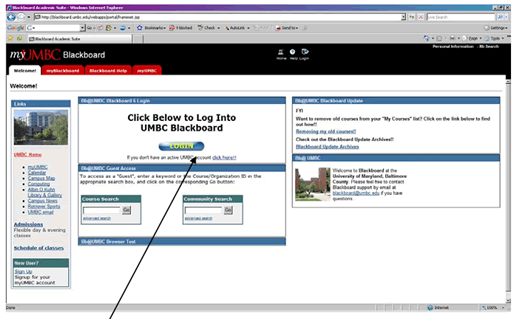
2. Click on LOGIN
3. You will see a list of courses that you are enrolled in. Click on your Spanish Course.
4. Click on COMUNICACIÓN
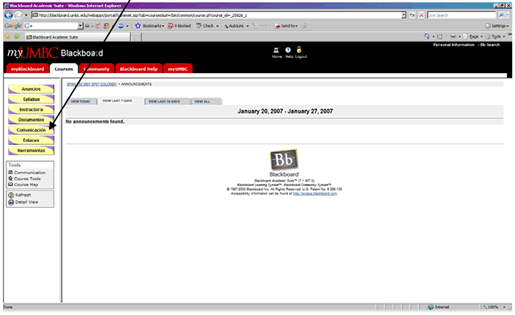
5. Click on DISCUSSION BOARD
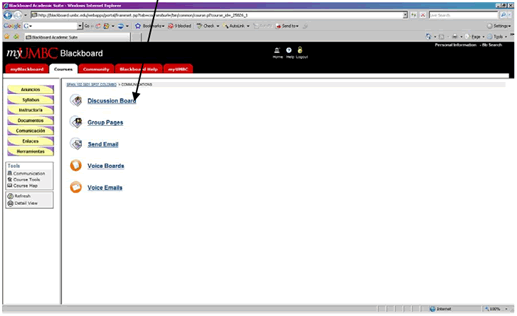
6. Read the prompt and then, click on THE TITLE OF THE PROMPT
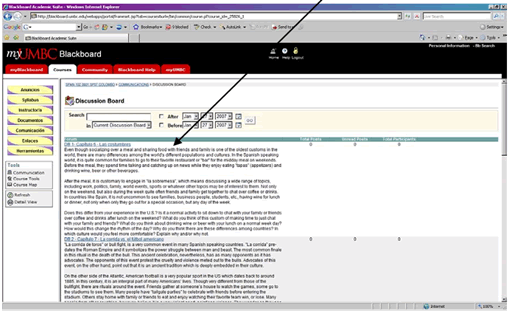
7. If you are the first person who posts in the Discussion Board, you can only add a new thread. To post a new thread Click on THREAD
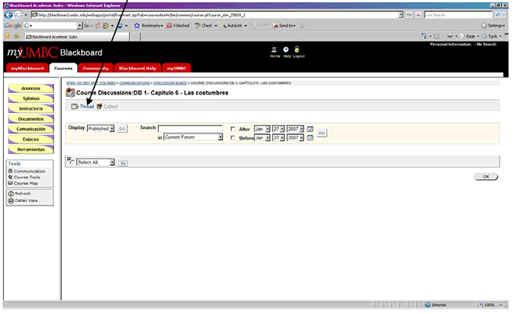
8. Here is where you type your thread. Be sure to provide a pertinent subject. Remember that this is what your classmates will see when they access the discussion board. The subject is the title of your post, so it should summarize it. Try to avoid obvious subjects like ''Discussion board #1''. When you finish writing your post, click on SUBMIT
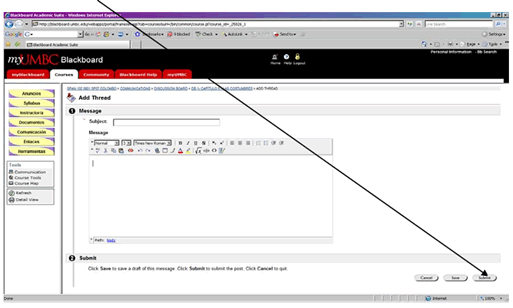
10. To reply to a classmate, follow steps 1 to 6. You will see the subject of the threads that your classmates posted. To read your classmates' posts, click on THE TITLE OF THE THREAD.
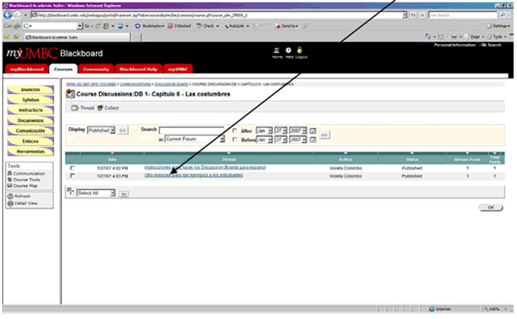
11. After you click on the title of the thread, you can read your classmates posts and you can reply to them. To reply to a post, click on REPLY.
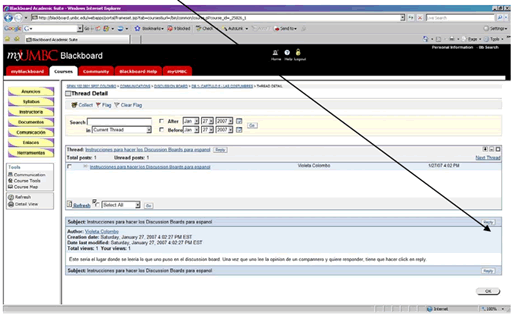
12. The following screen will appear. You can choose to see your classmate's post while you are replying to it by clicking on SHOW ORIGINAL POST. Write your reply, and click on SUBMIT
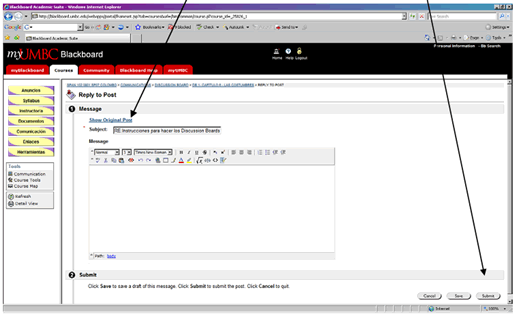
Grading
The following rubric will be used by your instructor to evaluate your participation in the Discussion boards:
